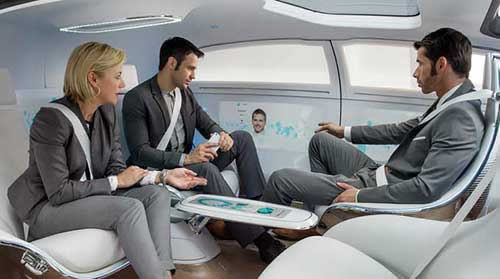|
|
||||||||
In part one of this report, I detailed some of the pilot projects Mercedes-Benz has innovated, stuff like the apparently increasingly popular Car2Go and a kiddie limo/bus system called Boost by Benz. But we were really there to learn about Mercedes' future vehicles, truly smart cars (as opposed to the Smart car) that point to the future of motoring, if you can call it motoring when you're sitting backwards in the front seats, jawing or playing cards with the rear seat passengers while the Mercedes-Benz takes on all the driving duties for you.
Speaking of that, Mercedes-Benz introduced its F 015 Luxury in Motion concept at the 2015 Consumer Electronics Show in Las Vegas - the car that prompted my comment above about rear-facing front seats. They didn't have it on hand, alas, but Ralf Lamberti, Director, User Interaction & Security for Daimler AG, outlined some of its features and benefits, as well as the issues they had building the car. "The car of the future is growing beyond its role as a mere means of transport," he said, adding that "the automobile will ultimately become a mobile living space." Since the F 015 drives itself, the cabin can be transformed from a driver-focused, steering wheel and pedal-controlled environment into what he described as a personal haven. "Here at Sunnyvale," he said, "we worked on the user interaction. One key aspect was the continuous exchange of information between vehicle, passengers and the outside world."
Key questions the designers and engineers dealt with included how the car recognizes its surroundings, as well as how the car can understand its passengers and communicate with them. "The complex algorithms of autonomous driving were one thing," Lamberti said, "but just as challenging were interface and interaction. In the end, we worked with six display screens integrated into
the instrument panel and the rear and side panels. Passengers can interact intuitively with the car in every way communication exists: Through gestures, eye-tracking or by touching the screens."
The result is a high tech and (apparently) comfortable and luxurious mobile cocoon that looks as capable of being used as a moving office as it does party central.
Autonomous vehicles are, indeed, coming (some are here already, in limited service), but what does that mean for those who enjoy the process of driving? I can't say, yet, but as long as self-driving vehicles can be put into manual mode and still offer a good driving experience I'm all for them: the sooner the oafs (and those who don't enjoy driving) turn the dirty deed of driving over to the droids the happier I'll be.
The autonomous car topic proved to be one of the most interesting in our day full of fascinating focuses. Surprisingly enough, while the talk dealt with the technology involved in creating "smart" cars, the most thought provoking discussion focused on the ethics - such as the decisions a robot vehicle will have to make when it's out in the real world of traffic.
For example, what happens when a precocious but oblivious little kid runs out from between two parked cars? Sure, the car can be programmed to brake, but what if there isn't time? Can it decide instead to swerve into the other lane and thus avoid EMS having to mop up the moppet? Sure it can - but what if there's a school bus full of other kids heading toward you in the other lane? Heck, I'm not sure I'm smart enough to make that decision quickly enough - let alone quick enough to act on the decision.
Imagine that conflict multiplied by however many autonomous vehicles end up on the road!
It made me think of the movie "I, Robot" again, in which the lead character's life had been saved by a robot years before, but at the cost of a young girl the droid determined had a lesser chance of survival than Will Smith's character. It's a great movie, but I daresay Mercedes would rather you didn't watch it, if only because of the really blatant Audi product placement…
Anyway, these questions have to be answered by the designers, programmers and engineers before autonomous cars can succeed. Otherwise, it's sure that the lawyers will have their say.
Speaking of user friendliness, the Mercedes mavens also mentioned a future feature that will (should?) let you wake up your car from its slumber in a parking garage and have it come out to pick you up - a great thing for those who have trouble remembering where they parked. That's pretty cool.
We also got to look at some design concepts the folks in Carlsbad came up with - from exotic, sci-fi-looking vehicles to one that, if it hadn't only been in one quarter scale model form (and not for sale in any form), was so gorgeous I wanted to mortgage my kids to get one. As it turned out, it isn't a real car at all. It's the Mercedes-Benz AMG Vision Gran Turismo, which was created for the popular video game.
When I got home I sallied forth to GT6 so I could download it to my fantasy garage. Alas, as with most of Mercedes-Benz' real cars, I couldn't afford it.
The company also gave us a look at how their collaboration with companies such as graphics processor maker NVIDIA is helping in their design. Seems they're using the same technology and processing power to design their vehicles as the major movie special effects houses use to create their fantastic, CG worlds. This is also helping lead to such things as smart instrument panels. I'm kind of blue skying this from what I saw at the demo, but imagine this: instead of a check engine light coming on and freaking you out because you don't know if you'll be left on the side of the road or incinerated, you'll instead get a 3D rendering of your vehicle, with the issue highlighted so you know exactly what's wrong. This can not only give you peace of mind, it can also arm you with knowledge you can take to the dealer with you. Not that you shouldn't trust dealers, right?
There was a lot more to the dizzying day of displays and seminars Mercedes-Benz put on for us, including discussions of such concepts as how a vehicle can offer increased connectivity without adding to the driver distraction issue, how the company uses philosophers and engineers to work together to tackle the big ethical issues of autonomous vehicles (such as the kiddie conundrum outlined above), how such mundane things as ice and snow could affect the sensors such vehicles will need to function, and plenty more. My head spun after the day, and I'm a technophile!
The Sunnyvale centre now has some 240 people pushing the outside of the automotive envelope and the company is quick to say how important the facility is to their overall vision. According to Prof. Dr. Thomas Weber, Member of the Board of Management of Daimler AG responsible for Group Research and Mercedes-Benz Cars Development (try fitting that onto a business card!), "through the special spirit in this center, we are already successfully anticipating today the customer wishes of tomorrow" because the R&D centre - and the hotbed of techno-thought that is Silicon Valley itself - is allowing Mercedes-Benz to bring new technologies to the road even faster and more efficiently than before. That should also help their competitive position.
Mercedes-Benz is undoubtedly not alone in such research and development, but they certainly seem to be pushing the state-of-the-art with it. Thanks to centres of excellence such as this, the future of the car, SUV and truck should turn out to be a very interesting one, whether you like the proverbial spirited ride or would rather kick back with your favourite movie, book, or website while R2D2 handles the chore of getting you from point A to point B.
Copyright 2015 Jim Bray
TechnoFile.com
Jim Bray is a member of the Automobile Journalists Association of Canada. His columns are available through the TechnoFile Syndicate.
Reviews by Brand |

